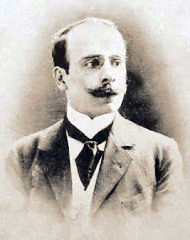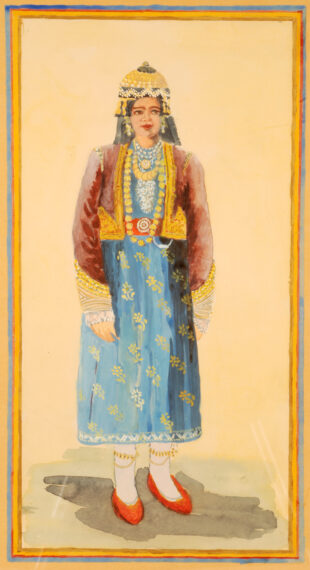ARSHAK FETVADJIAN (1863–1947)
Female costume from Yerevan
ARSHAK FETVADJIAN (1863–1947)
Female costume from Yerevan
Watercolour on paper
 Born in Trebizond, he spent his childhood in Constantinople. He was an extremely talented watercolourist. His trips taken to Italy, Austria, Germany, France and Russia from 1884 to 1888 enabled him to connect with many intellectuals.
Born in Trebizond, he spent his childhood in Constantinople. He was an extremely talented watercolourist. His trips taken to Italy, Austria, Germany, France and Russia from 1884 to 1888 enabled him to connect with many intellectuals.
In 1900, while taking a train from Tiflis to Gumri (Alexandropol), he was dazzled by the landscapes of the Dzoraget valley in the north-east of present-day Armenia and those of the Shirak region.
For the next twenty summers, he never stopped painting the ruins of Ani in Turkey, and searched far and wide over Eastern Armenia and Russia in search of Armenian ruins. He loved reproducing monuments in situ for archaeological, historical and artistic purposes. He made over two thousand sketches and watercolours of the monuments of Eastern Armenia. From his series of watercolours of traditional Armenian costumes it is clear that he was an accomplished watercolourist with a keen sense of observation. His meticulous reproductions of materials, furs, velvets, silks, embroideries and jewellery are an important source of ethnographic details that were used for restoring regional costumes. His work forms the basis of a collection that is invaluable for understanding how people lived at that time. He also wrote a number of works on the history of Armenian architecture with the assistance of the priest and historian Ghevond Alishan (1820–1901).
His series of works on Ani and on costumes were exhibited in Paris in 1919. He went to London and later to the United States, and settled in Medford, Oregon, hoping one day to return to Armenia. But life did not give him enough time; he died, far from his beloved homeland, in Medford in 1947 at the age of 84.
In accordance with his wishes, however, his ashes were returned to Armenia and a large part of his works were donated to the National Gallery in Yerevan.
Frédéric Fringhian
